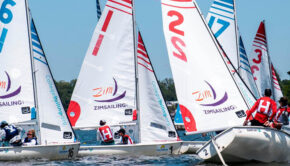Welcome to College Sailing in 2019
Published on February 26th, 2019
by Tyler Colvin, Assistant Sailing Coach, Old Dominion University
While college sailing has a long and storied history, as a sport, it has grown and changed drastically in the last 20 years. However, the popular perceptions of college sailing and the college admissions process haven’t necessarily kept up with this changing reality.
This article hopes to serve as a reintroduction to college sailing and to educate coaches, parents, and sailors alike on the current state of the game.
College Sailing: An Overview
College sailing should be treated and thought of as its own one-design class. Much like a one-design class, it is sailed in unique boats with its own procedural rules and structure. It shares the same framework as high school sailing (ISSA), but differs greatly from the youth sailing circuit, which many are accustomed. A premium is put on fitness in college sailing with all of the top teams working hard to be high level athletes.
The Intercollegiate Sailing Association (ICSA) is an organization of just under 200 teams in seven conferences across the U.S. and Canada. It is almost completely run by volunteer coaches and stakeholders. On Tech Score (ICSA’s proprietary scoring program), over 320 events were run in the 2017-2018 school year by member teams and supporting yacht clubs. In 2008-2009, there were around 120 events run.
Of these events, there are six annual National Championships; Match Race, Men’s Singlehanded and Women’s Singlehanded Championships are in the fall and Coed, Women’s and Team Race Championships are in the spring.
With more teams hiring full time coaches, the development of Tech Score, and teams investing an estimated $22 million in capital improvements over the last 20 years, college sailing is more sophisticated and professional than ever. Top teams are working with full time strength and conditioning coaches, filming and analyzing video and using sports psychologists to help their athletes improve. There is suddenly a demand for drone operators, nutritionists and team building experts.
The vast majority of college sailing is sailed in Collegiate FJs and 420s. These collegiate doublehanded dinghies do not have a trapeze or spinnaker and the sail controls are very basic. Keeping the boats simple allows for college sailing to be accessible for those without much sailing experience and to reduce costs for teams purchasing and maintaining their own equipment.
Regattas are weekend events and are typically sailed in two divisions, “A division” and “B division”, of up to 18 boats. The target time for a college race is 18-22 minutes and hosts aim to sail 12-18 races per division (A and B), per weekend with no throwouts.
The fall season starts the first weekend in September with most conferences wrapping up their fall championships by Halloween. In the spring, regattas start in February and run through April with the spring National Championships taking place the week prior to, and after, Memorial Day Weekend. The number of weekends a team can compete during a school year is capped at 18.
College Sailing, A Cross Section
Within the 200 or so teams in the ICSA, there are several different types of teams. While they all compete against each other, some teams have more structure and funding than others; Club, “Elite” Club, and Varsity.
Club teams make up the vast majority of the ICSA. They are student run, led and funded organizations. Club teams are partially funded through a schools’ campus recreation, club sports organization, or sailor dues and rely heavily on strong student leadership. Many club teams do not have a coach and operate on a tight budget.
The strength of a club team comes from the membership and is a great way for students to showcase their talents and grow as leaders. Strong club teams almost always come with significant support from their parent department, whether that be Campus Recreation or Club Sports Department.
Student leadership is responsible for scheduling regattas, team finance, team travel and organization. They work with campus recreation and advisers to get practice times, build a regatta schedule and securing funding from the school, parents and alumni. Club teams are an excellent venue for students to take ownership of an organization and help it to grow and improve.
There are currently 39 varsity teams in ICSA. These teams are funded through the Athletic Department and fundraising, and have full time coaches and dedicated sailing facilities (some lease space through yacht clubs and some have facilities owned by the University). Varsity teams tend to have more resources than club teams and can afford to go to more events.
Many varsity sailing teams are subjected to the same treatment as other varsity sports at their school, such as basketball, football and soccer. The standards set for these teams may include a minimum GPA, study hall hours, drug testing and philanthropy. Varsity teams are time intensive for student athletes and require the development of good time management skills.
With all these commitments, schools often provide a high level of support needed to succeed at both being a student and an athlete. Most varsity programs are supported by the athletic department and come with tutors, trainers, facilities and academic advisers dedicated to helping the team succeed.
Elite Club teams fall into a very small category of teams in ICSA. They are funded as well, or better, than varsity teams, often times following similar requirements with academics and compliance, but are not funded through the Athletic Department. They have full time coaches, facilities, and some school support.
Unique to college sailing, all of these types of teams compete against each other on any given weekend. There are tiers of events, but at each level there are varsity athletes competing against club athletes in Coed and Women’s regattas. College Sailing provides opportunities for many levels of sailor to compete against each other.
Skip the Racing Clinic, Go to the SAT Prep Class
In a 2013 letter to Yale Head Coach Zach Leonard, Greg Wilkinson of Boston College estimated that 15-20 students get into schools that they would not have gotten into had they not had support of a coach. This represents less than 2% of students applying to college with sailing resumes.
It is arguably one of the most exclusive clubs in collegiate athletics. The students who are getting these benefits are winning national level youth sailing events and podium-finishing at international events. Do NOT count on a sailing resume to get a student into school, because it will NOT.
(Editor’s note: But per the stats given, it will help for 2% of the total athletes, and given how these benefits are limited to maybe 10 schools, that 2% could be a more significant percentage of those rosters.)
That being said, this should not dissuade young sailors from applying to their dream schools. Top tier schools provide an excellent academic experience. But having good grades and test scores provides a much better chance of getting into school than a sailing resume. The vast majority of college sailors have their academic profile meet the academic profile of the school they attend. The best way to sail for an Ivy League school is to have the grades to get into that school first.
College coaches are NOT looking for sailors to come out of any particular class of boat. Many successful college sailors have sailed a variety of classes. The “perfect boat” does not exist for prospective student athletes. Continuing to play team sports throughout high school is important as many coaches are looking for multi-sport athletes.
Because of the team nature of college sailing, and the inherent individual nature of youth sailing, it can be hard to make the transition onto a college team with no team sport background. Continuing to play team sports throughout high school is valuable and athletes should be cautious to specialize too early.
There Are No Scholarships in College Sailing
In Procedural Rule 12f it states: “Financial Assistance – No student-athlete shall receive financial assistance to attend college based upon sailing ability. Furthermore, no coach or representative of an athletic interest related to sailing shall influence, or attempt to influence, financial aid decisions on behalf of a prospective student-athlete. This shall not prohibit coaches or other representatives from providing and discussing general financial aid information with prospective student-athletes.”
A sailor attending a university to sail may receive a large financial aid package, however, this should not be misconstrued as a sailing scholarship. It is money provided on their academic merit or economic need.
ICSA feels that disallowing athletic scholarships keeps the playing field more level between well funded varsity teams and smaller club teams, and that this interaction between all of these teams is an inherent benefit of College Sailing.
Again, there are no scholarships in College Sailing.
From Grand Prix to Dirt Track: Choosing a School
If youth sailing with support boats, snacks, and myriad of coaches is Grand Prix racing, college sailing is most certainly rough and tumble Dirt Track. Teams often drive long distances for long, cold regattas, only to drive home to exams and papers. It is a different beast and choosing the correct program is often times a difficult and confusing process.
College sailing should enhance a sailor’s college experience, but not define it. When choosing a school, it is important that the sailor likes where they are for what it is, not because they are there to sail. If something were to happen and they were not able to participate, it’s important that they like the school for reasons other than it has sailing.
Beyond the guidance counselor’s recommendation based on desired school size and area of study, students wishing to sail in college should also consider their own sailing experience and what they want to get out of college sailing.
A sailor with a strong racing background who traveled and sailed competitively throughout the year may struggle on a club team requiring more self-discipline and having less structure. This is not always the case, as many strong youth sailors have had successful club team careers and thrived as self-starters and leaders on these student run teams. Likewise, a casual racer and cruiser throughout youth sailing may not enjoy the rigors of a varsity team. But again, there are certainly exceptions here as well.
Sailors should start reaching out to coaches at schools that they are interested in sometime in their Junior year. It should be noted that college coaches are among the most difficult to get hold of communication-wise, so persistence is key.
If the coach doesn’t respond to the first email, try, try again until they respond. Alternatively to electronic communication, many coaches work at yacht clubs over the summer and coach major events and clinics throughout the country. It is worth it for a sailor to introduce themselves to coaches at clinics and regattas when they have the chance.
Once contact has been established by the sailor, the next step is to go for a visit during the academic year. (It is important to college coaches that the sailor themselves is contacting them; being contacted by a parent is less desirable). Teams, club or varsity, are typically open to having sailors come visit and spend time with them. While on campus, take a guided tour, meet advisors, eat at the dining hall, go to classes, and see the school and environment around them is appealing.
Things to ask a coach:
• How many regattas do you attend on a weekly basis?
• What kind of support do you have from the university?
• Do freshmen get the opportunity to race?
• What does a weekly schedule look like?
• Is there a separate workout schedule?
• How much travel is involved?
• How are athletics and academics conflicts handled?
• What are the typical majors of team members?
• What are you looking for in an incoming sailor?
• What kind of expenses are players required to cover?
• How many hours a week are athletes required to participate?
• What can I be doing between now and the admissions date to make the team?
• What happens next?
Talk to Your Sailors About College
Coaches, parents, and advisors of youth sailors have an enormous amount of influence, whether they know it or not. An average teenager may not have thought much about what kind of college experience they want and having a dialogue may help them in this process.
Ask them to do research on college teams and talk to other sailors from the area who have college sailing experience. Most importantly, reach out to local coaches (repeatedly, as college coaches typically don’t communicate well) to ask questions. Many coaches are happy to come talk to a group of sailors and help give them guidance.
College sailing is an incredible sport with room for sailors of any level and finding the correct fit is as simple as asking the right questions.
Source: US Sailing









 We’ll keep your information safe.
We’ll keep your information safe.